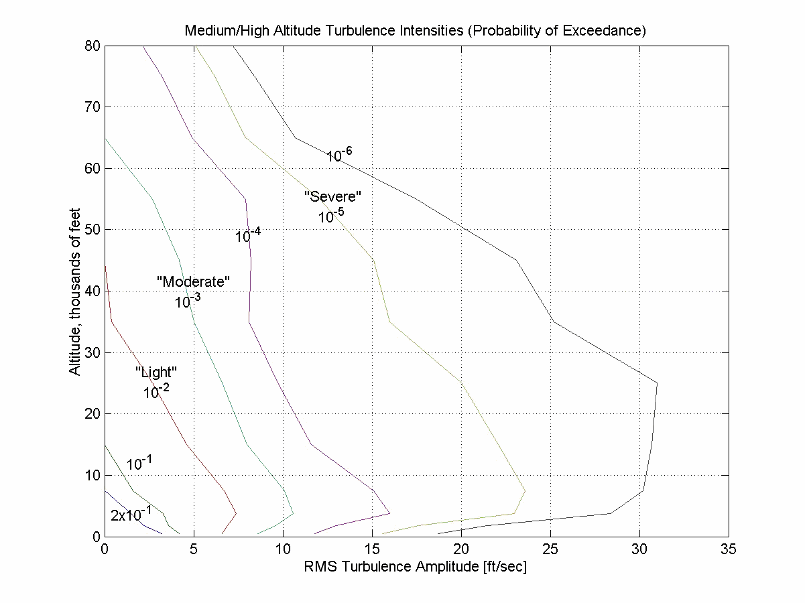Dryden Wind Turbulence Model (Continuous)
Generate continuous wind turbulence with Dryden velocity spectra
Libraries:
Aerospace Blockset /
Environment /
Wind
Description
The Dryden Wind Turbulence Model (Continuous) block uses the Dryden spectral representation to add turbulence to the aerospace model by passing band-limited white noise through appropriate forming filters. This block implements the mathematical representation in the Military Specification MIL-F-8785C, Military Handbook MIL-HDBK-1797, Military Handbook MIL-HDBK-1797B.
Limitations
The frozen turbulence field assumption is valid for the cases of mean-wind velocity and the root-mean-square turbulence velocity, or intensity, is small relative to the aircraft ground speed.
The turbulence model describes an average of all conditions for clear air turbulence. These factors are not incorporated into the model:
Terrain roughness
Lapse rate
Wind shears
Mean wind magnitude
Other meteorological factors
Ports
Input
Output
Parameters
Algorithms
References
[1] Chalk, Charles, T.P. Neal, T.M. Harris, Francis E. Pritchard, and Robert J. Woodcock. Background Information and User Guide for MIL-F-8785B(ASG), "Military Specification-Flying Qualities of Piloted Airplanes." AD869856. Buffalo, NY: Cornell Aeronautical Laboratory, 1969.
[2] Flying Qualities of Piloted Aircraft. Department of Defense Handbook. MIL-HDBK-1797. Washington, DC: U.S. Department of Defense, 1997.
[3] Flying Qualities of Piloted Aircraft. Department of Defense Handbook. MIL-HDBK-1797B. Washington, DC: U.S. Department of Defense, 2012.
[4] Flying Qualities of Piloted Airplanes. U.S. Military Specification MIL-F-8785C. Washington, D.C.: U.S. Department of Defense, 1980.
[5] Hoblit, Frederic M., Gust Loads on Aircraft: Concepts and Applications. Reston, VA: AIAA Education Series, 1988.
[6] Ly, U., and Y. Chan. "Time-Domain Computation of Aircraft Gust Covariance Matrices." AIAA Paper 80-1615. Presented at the 6th Atmospheric Flight Mechanics Conference, Danvers, MA, August 1980.
[7] McFarland, Richard E. "A Standard Kinematic Model for Flight Simulation at NASA-Ames." NASA CR-2497. Mountain View, CA: Computer Sciences Corporation, 1975.
[8] McRuer, Duane, Dunstan Graham, and Irving Ashkenas. Aircraft Dynamics and Automatic Control. Princeton, NJ: Princeton University Press, 1974, R1990.
[9] Moorhouse, David J., and Robert J. Woodcock. Background Information and User Guide for MIL-F-8785C, "Military Specification—Flying Qualities of Piloted Airplanes." ADA119421. Wright-Patterson AFB, OH: Air Force Wright Aeronautical Labs, 1982.
[10] Tatom, Frank B., George H. Fichtl, and Stephen R. Smith. "Simulation of Atmospheric Turbulent Gusts and Gust Gradients." AIAA Paper 81-0300. Presented at the 19th Aerospace Sciences Meeting, St. Louis, MO, January 1981.
[11] Yeager, Jessie, Implementation and Testing of Turbulence Models for the F18-HARV Simulation. NASA CR-1998-206937. Hampton, VA: Lockheed Martin Engineering & Sciences, 1998.
Extended Capabilities
Version History
Introduced before R2006a


